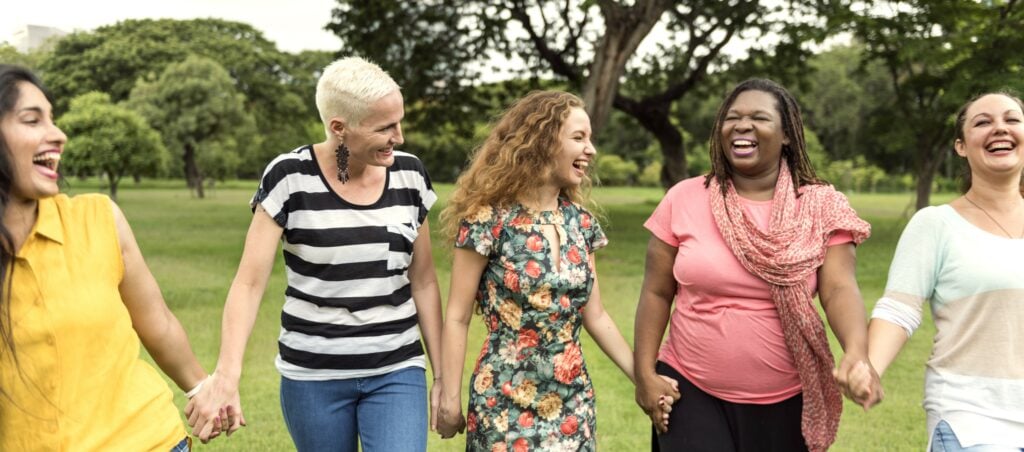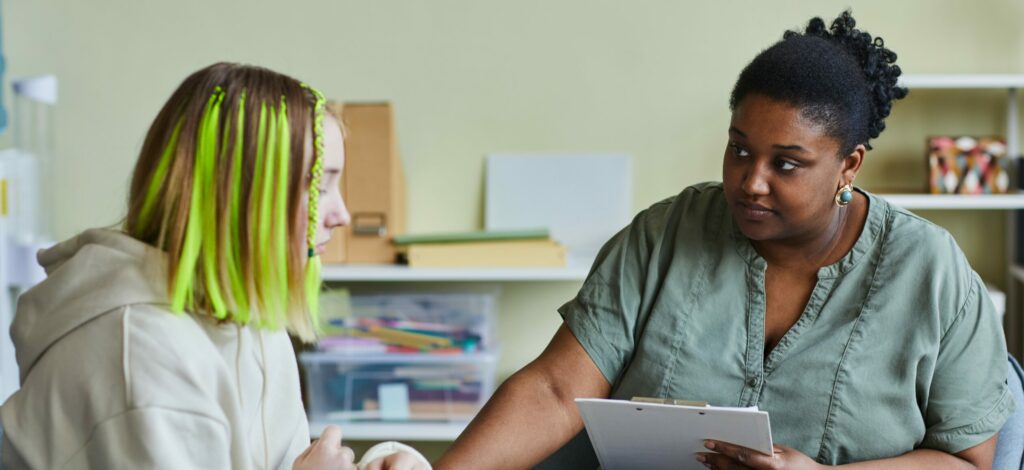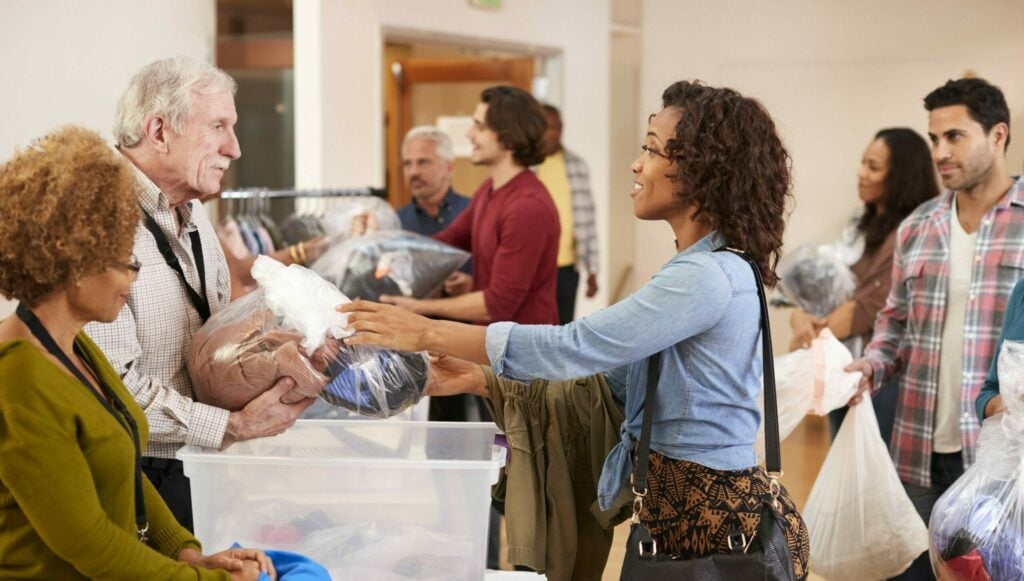How community engagement benefits your mental health
Reviewed by Brooks Baer, LCPC, CMHP


Seeking safety and stability for their young family, Charissa Pizarro’s grandparents fled the Dominican Republic in the years following that country’s 1965 civil war. Though Pizarro was born in America, her family returned to their country of origin for a little while before immigrating permanently to the US.


“When I came here as a young girl, I had an experience very similar to a lot of immigrants. I had to learn English and I had to acculturate,” says Pizarro, who holds a PsyD degree and now works as a clinical psychologist. The community where she lived was crucial in helping her family establish their lives in the States.
It was this experience that drove Pizarro to become active in her community as a professional, and today she works with immigrants in a variety of ways.
“Community engagement is a moral imperative for me,” she says. “It’s something I need to do.” For people on both the giving and receiving ends, it can be life-changing.
What does effective community engagement look like?
The Centers for Disease Control and Prevention (CDC) defines community engagement as the act of working with or through a group to address the issues affecting that group.1 According to Pizarro, effective community engagement meets people where they are with a range of services.
“It’s not just providing help in one way,” she says. “It’s seeing the whole picture. To be effective, you must figure out what the community needs and either provide what you can or connect them with resources for the things you can’t.”
Community needs vary widely, but here are some common examples of ways you can help:
Connect your community to food. The US Department of Agriculture uses the term “food insecurity” for people who don’t have consistent access to food. As of 2021, the organization estimated that 34 million people, including nine million children, were food insecure.2 Food banks, community centers, and other organizations need volunteers to help make sure everyone in the community can eat regularly and healthfully.
Support people who don’t have housing. According to data from 2020, America had more than half a million unhoused people that year.3 Neighborhoods with high concentrations of unhoused people are often looking for ways to provide short-term shelter while seeking long-term solutions. Volunteers are always in demand at shelters, and you can also donate gently used supplies like linens and clothes, as well as new personal hygiene items like toothbrushes, tampons, and diapers.
Prepare for medical emergencies. When catastrophes like house fires or natural disasters displace families, organizations like the Red Cross can help. You can lend a hand as well: Donating blood, for example, is a great way to ensure your community has the resources it needs if disaster strikes.
Spend time with your neighbors. An estimated quarter of elderly Americans are considered socially isolated, which can take years off their lives.4 Many eldercare homes welcome volunteers to visit residents. You can also check on a neighbor or get involved with a senior center near you.
Help keep your neighborhood safe. Volunteering your time for a neighborhood watch or advocacy group can help protect vulnerable people in your community. Many rural communities also rely on volunteer fire departments, which frequently need new recruits.
The positive impact of getting involved
Community engagement offers many mental and physical benefits. Not only can you find satisfaction in helping out your community or another in your area, but the act of volunteering can support your own health in a number of ways:
Improving overall health: In one study of older adults, volunteers were more likely to engage with preventative health care services like vaccines, cancer screenings, and necessary bloodwork.5 They also spent fewer nights in a hospital.
Lessening chronic pain: In another study, researchers trained patients suffering from chronic pain to help treat their peers. After volunteering, those patients reported a significant decrease in depression, as well as improvement in their own pain.6
Helping you live longer: Older adults who volunteer up to 40 hours a year live longer, research shows.7 This is especially relevant if you live alone and are socially isolated.
Increasing happiness: Working in the community can help make people happier by decreasing isolation and depression.8
Lowering anxiety: People often feel less anxious when doing volunteer work, says Pizarro: “Sometimes when we have a lot of anxiety around an issue, it helps to know that you’re doing something for your community.”
Increasing self-esteem: Prosocial behaviors like sharing and helping can help increase self-esteem, especially among young people. Studies show that a strong sense of self-esteem can act as a protective factor against aggression, depression, and drug and alcohol misuse.9
These benefits apply no matter where you volunteer, but serving communities who have been systemically excluded can make an even greater difference.
Pizarro sees this firsthand in her work with undocumented immigrants, especially those who’ve fled violence. “These groups are carrying a lot of trauma, and they don’t trust easily. It is very significant to build connections they can carry forward,” she says. “Having those connections decreases isolation, which in turn decreases anxiety and depression.”
Is compassion fatigue a risk?
“Compassion fatigue” describes the state of emotional and physical exhaustion experienced by people in helping professions. During the COVID-19 pandemic, for example, many in the medical and teaching fields were forced to do their jobs under extraordinary circumstances, which left them burned out and depleted. This can also happen to volunteers or activists, especially when things are frustratingly slow to improve.
In a study conducted in South Australia, some volunteers reported experiencing high levels of exhaustion and stress, conditions that can affect physical health.12 However, the same study indicated that while compassion fatigue is a concern, the protective factors of social connection and increased self-esteem can help mitigate that risk.
Activism as community engagement
Powerful change can happen when communities rally around a specific cause. Activism can include things like:
Encouraging communities to vote. Volunteers with a range of organizations can canvas neighborhoods, help people register to vote, and even provide transportation to the polls. Some states have initiatives directed at helping specific populations, such as California’s Native Vote Project or MTV’s Rock the Vote.
Writing letters or signing petitions. When the state of Oregon didn’t follow through with millions of dollars designated for a proposed veterans home, vets and other supporters in the area started a letter-writing campaign to pressure local authorities to honor their initial agreement.10 While the funding has been slow, the community’s voices were heard, and the home is expected to be built by 2028.
Demanding an audience. When a Pennsylvania senator stopped meeting with his constituents, some of them formed a group and went to his office at lunch every Tuesday.11 “Tuesdays with Toomey” grew across the state and soon flooded the senator’s office with protesters. Those who couldn’t meet in person called, sent postcards, and even faxed their frustrations.
Marching, sitting in, or lying down for a national cause. Communities can come together to join a national cry for change. Inspired by the Freedom Riders and other civil rights activists of the 1960s, peaceful protestors have stood up for many different causes over the decades. A number of national protest events, such as March for Our Lives, encourage people to organize corresponding local events to show support.
Show the next generation how it’s done
Community engagement and activism both set a positive example for young people. A great way to help your kids grow up to become active community members is to include them in your own volunteer work. Children can benefit from interacting with other generations, as well as see change happening up close. Studies show that two-thirds of kids who volunteer grow up to be engaged adults.13 Not sure where to start? PBS offers tips for volunteering with your kids.14
The same holds true for activism. It can be inspiring for young people to see their parents, teachers, and community leaders take action. “Our kids need to see it somewhere to know it’s an option,” Pizarro says. “They also know that we’re working toward change even if it doesn’t come about right away, which it usually doesn’t.”
In recent years, young people have become more engaged in activism to address climate change and gun violence, two issues disproportionately threatening their generation.15, 16 This activism has benefits beyond inspiration, experts say. In a 2018 study, teenagers and young adults who engaged in activism reported staying in school longer and going on to earn higher incomes.17
Pizarro took to the streets in her own community after the murder of George Floyd, and she says her young daughter begged to come along.18 While Pizarro felt those particular protests were too intense for her daughter, she was glad for her interest. “She tells me all the time that she’s going to protest and be active when she’s older, and I’m proud of that,” she says.
The power of connection
Sometimes the world’s problems seem overwhelming. You may not know where to start to make change, and you may even feel powerless at times. Though you can’t solve everything at once, trying to make your corner of the world a better place is a great way to feel empowered.
Pizarro says the volunteers and local organizations who helped her family changed their lives, and she hopes people understand the power of just knowing someone out there cares and wants to help. “At the end of the day, there’s so much we can’t solve,” she says. “But lending some support makes such a big difference.”

Sources
1 https://www.atsdr.cdc.gov/communityengagement/pce_intro.html/
2 https://www.feedingamerica.org/hunger-in-america/food-insecurity/
3 https://endhomelessness.org/homelessness-in-america/homelessness-statistics/state-of-homelessness/
4 https://nap.nationalacademies.org/catalog/25663/social-isolation-and-loneliness-in-older-adults-opportunities-for-the/
5 https://www.sciencedirect.com/science/article/abs/pii/S0277953615302495/
6 https://www.sciencedirect.com/science/article/abs/pii/S1524904202000036/
7 https://academic.oup.com/psychsocgerontology/article/54B/3/S173/614263/
8 https://journals.sagepub.com/doi/abs/10.1177/0265407517716786/
9 https://www.sciencedirect.com/science/article/abs/pii/S0191886914000610/
10 https://www.nrtoday.com/news/veterans/veterans-launch-letter-writing-campaign-over-loss-of-state-funding-for-roseburg-veterans-home/article_11276c0a-f360-5f05-845e-26da05f90692.html/
11 https://billypenn.com/2017/02/02/pa-senator-pat-toomey-is-maybe-the-most-wanted-man-in-washington/
12 https://psycnet.apa.org/record/2004-95071-006/
13 https://youth.gov/youth-topics/volunteerism/
14 https://www.pbs.org/parents/thrive/tips-for-volunteering-with-kids/
15 https://www.frontiersin.org/articles/10.3389/fpos.2022.940876/full/
16 https://time.com/longform/never-again-movement/
17 https://srcd.onlinelibrary.wiley.com/doi/full/10.1111/cdev.12998/
18 https://www.mprnews.org/crime-law-and-justice/killing-of-george-floyd/
About the author
Amye Archer, MFA, is the author of “Fat Girl, Skinny” and the coeditor of “If I Don’t Make It, I Love You: Survivors in the Aftermath of School Shootings,” and her work has appeared in Creative Nonfiction magazine, Longreads, Brevity, and more. Her podcast, “Gen X, This Is Why,” reexamines media from the ’70s and ’80s. She holds a Master of Fine Arts in creative nonfiction and lives with her husband, twin daughters, and various pets in Pennsylvania.
Related articles

Powerful as a mother: The magic that happens when moms join forces
Moms are often nurturers and protectors. The urge to care for others comes from...

Caring for yourself when your job is caring for others
Mental health professionals help people in crisis and provide emotional support...

How to create positive change every day
Dr. Martin Luther King Jr. advocated for justice, peace, and freedom. You can...

The ripple effect of trauma from gun violence
Imagine each mass shooting as the epicenter of an earthquake. Even indirect...
